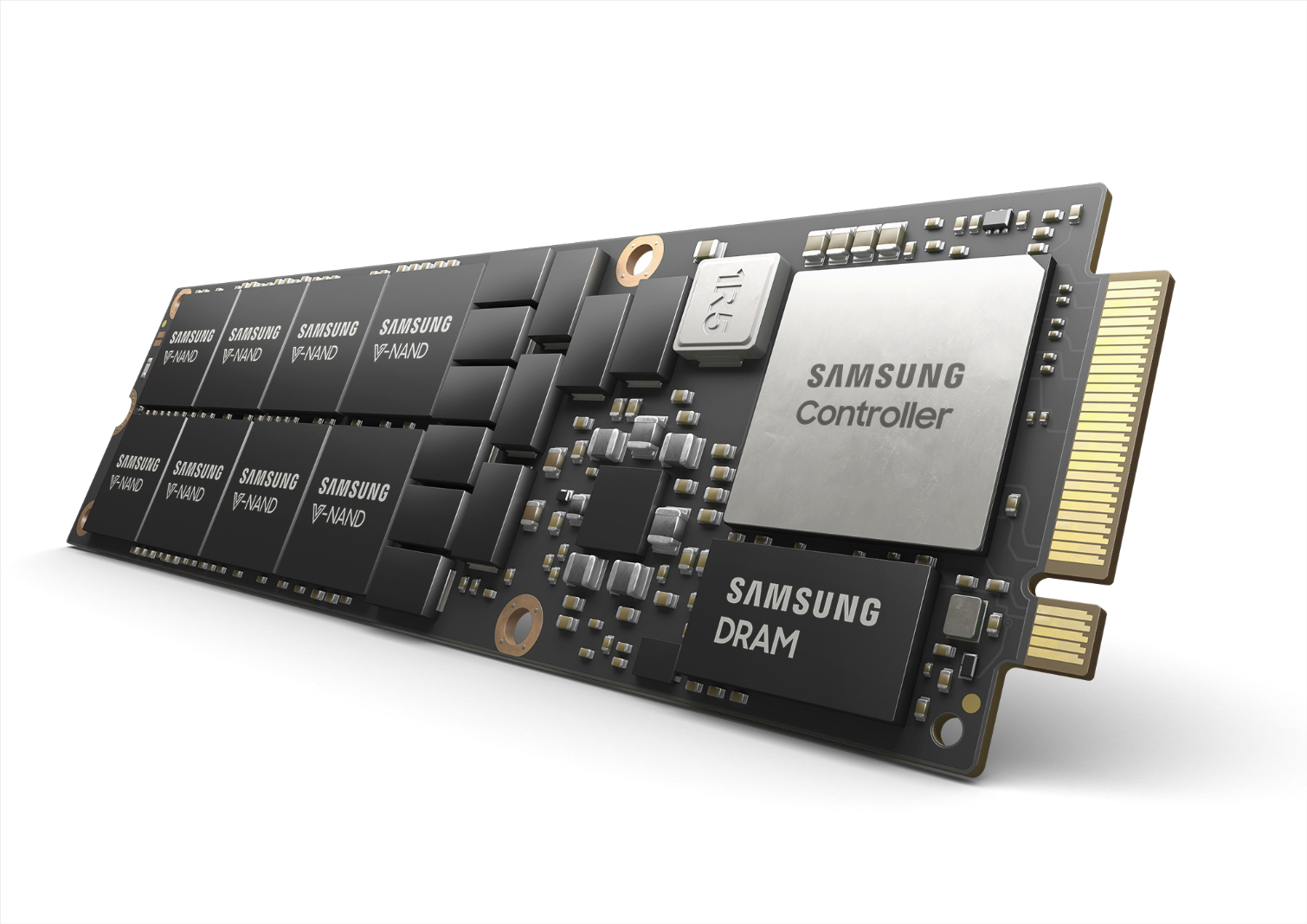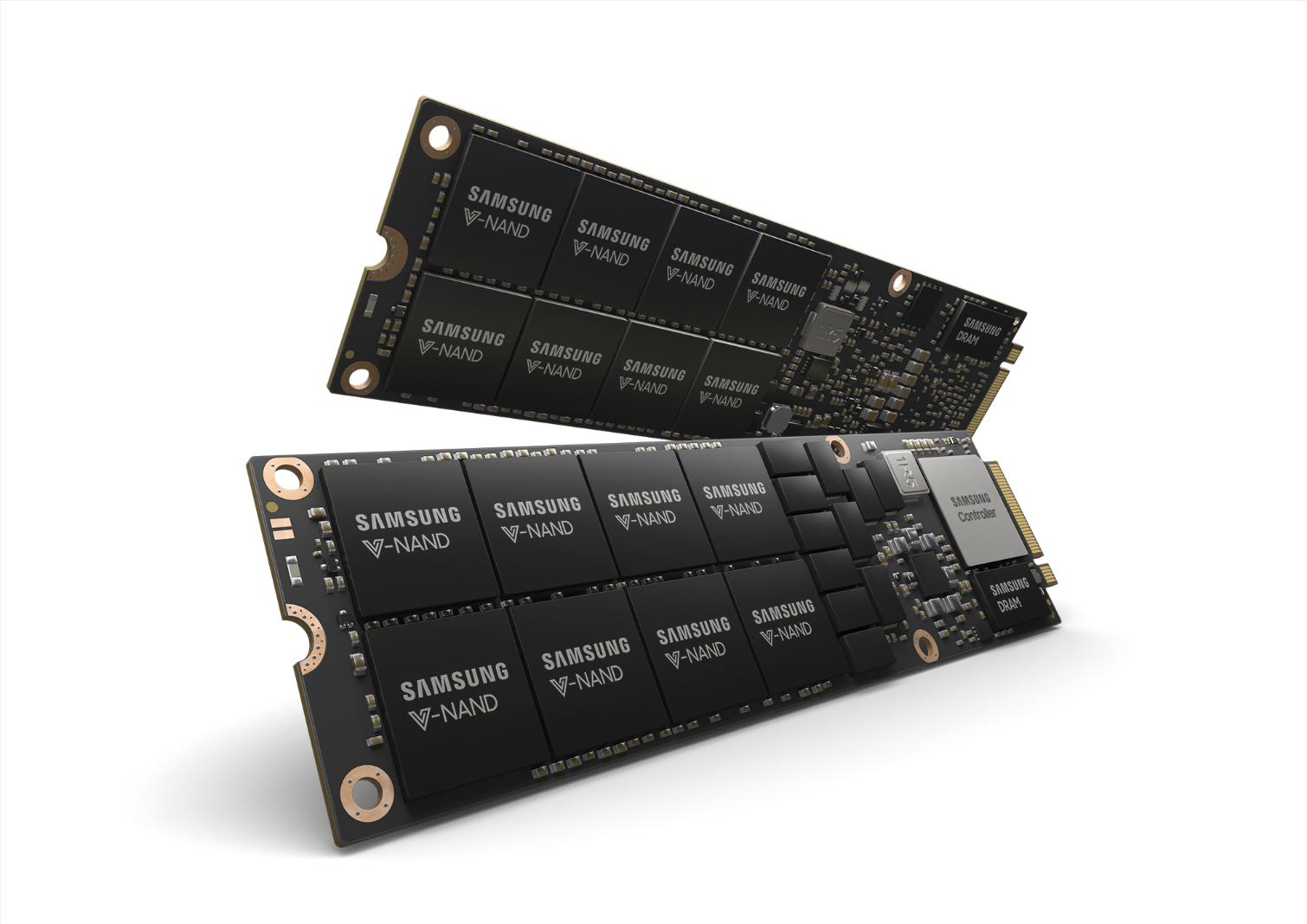Samsung Crams 8TB Into Its Next-Generation PCIe 3.0 x4 SSD
EDIT: Samsung has corrected its specifications to indicate the drive is not PCIe 4.0. Instead, it is PCIe 3.0 x4.
Samsung has come a long way from the days of exporting dried fish to becoming the industry’s leading solid-state drive manufacturer. The Korean giant’s dominance extends from the conventional SATA 2.5-inch drive to the latest M.2 form factor, but today it revealed an upcoming 8TB NVMe PCIe 3.0 x4 solid-state drive based on the NF1 form factor.
With a heavy focus on enterprise customers and data center, the Samsung 8TB NF1 is by far the company’s largest NVMe solid-state drive to date. It’s quite an achievement that Samsung can stuff eight terabytes of storage onto a printed circuit board that measures 110mm by 30.5mm. Samsung’s new solid-state drive officially belongs to the next-generation small form factor (NGSFF) NF1 category, which will be standardized by the JEDEC Solid State Technology Association in October of this year. In comparison to a M.2 solid-state drive with dimensions of 110mm by 22mm, an NF1 solid-state drive is only 8.5mm wider. However, the added area allows it to feature up to double the capacity of a simple M.2 drive. In its press release, Samsung bragged about how one of its partners installed a total of 72 of the 8TB NF1 drives into a 2U rack to amass up to 576TB of storage space.




Samsung’s secret to producing the 8TB NF1 resides in the company’s 512-gigabyte (GB) NAND packages. The solid-state drive expert soldered 16 of those bad boys to the printed circuit board of the solid-state drive. Each package is comprised of 16 layers of 256 gigabit (Gb) 3-bit V-NAND chips. Unfortunately, Samsung didn’t disclose the exact model of the controller. However, the company previously used one of its Phoenix controllers in past NF1 prototype drives.
On the bright side, Samsung did confirm that 8TB NF1 will employ a brand new high-performance controller that supports the NVM Express 1.3 protocol and a PCI Express 3.0 x4 connection. Therefore, the solid-state drive can deliver sequential read speeds of 3,100 MB/s and write speeds of 2,000 MB/s. It also offers 4KB random read performance up to 500,000 IOPS and 4KB write performance up to 50,000 IOPS. To put the icing on the cake, the 8TB NF1 also sports 12GB of LPDDR4 memory to accelerate data processing and improve energy efficiency. The drive is rated for 1.3 DWPD and backed by a three-year warranty.
Get Tom's Hardware's best news and in-depth reviews, straight to your inbox.

Zhiye Liu is a news editor, memory reviewer, and SSD tester at Tom’s Hardware. Although he loves everything that’s hardware, he has a soft spot for CPUs, GPUs, and RAM.
-
poopflinger So, the new M.2 that operates on PCI-E 4.0 has slower read and write speeds than the current Samsung 970 EVO M.2 that operates on PCI-E 3.0. Am I missing something here?Reply -
derekullo You may find it amusing to note that the 8TB NVMe PCIe 4.0 solid-state drive is now worth more than the combined value of all human organs and income produced by every inhabitant of *SUBJECT'S HOMETOWN*Reply -
tyns78 It's "3-bit V-NAND" now instead of TLC? Samsung better hope IMFT doesn't start making 3DXP profitable any time soonReply -
milkod2001 @POOPFLINGERReply
They are not meant for you but for server racks where combined together in large numbers they can provide huge amount of data at SSD speeds.Don't think you can stack together Samsung 970 EVO M.2 the very same way. -
joonas.pihlajamaa Yes I was extremely confused by the dimensions, 11cm x 30.5cm is basically 4" by 12" (1 foot long!) and it would be "a bit larger" than standard M.2 drive. I know the metric system is hard, but it's not that hard! Left me scratching my head about the "amazing capacity" until I got even more confused with the M.2 comparison and understood the numbers are likely wrong.Reply -
Kridian "With a heavy focus on enterprise customers and data center..." Does anyone else just read that and go, ok, f#** that - can't afford it. Next article.Reply -
rferreira.dba For the record: the Imperial system is hard. The metric system is common sense. ;-)Reply -
supremelaw 110mm by 30.5mm is 8.5mm wider, NOT 8.5mm longer.Reply
Thus, instead of a width of 22mm, this NF1 form factor
adds 4.25mm to each side, but the overall length remains
110mm. As such, it may not fit into the M.2 slots that
are integrated on many late model motherboards.
Also, we did a visual inspection (without careful measurement),
and this NF1 form factor may be too "wide" for the
ASRock Ultra Quad M.2 add-in card. Half-height AICs
with room for 2 x M.2 SSDs may have room for this
new form factor, however. Time will tell.